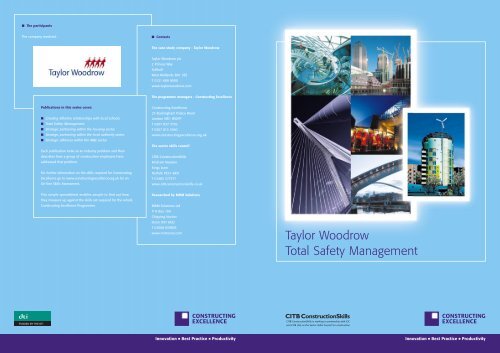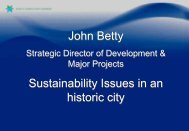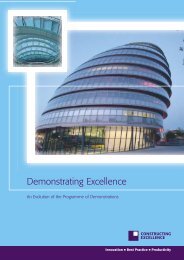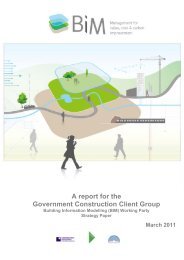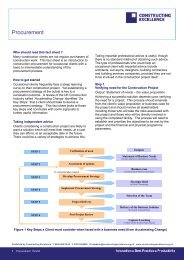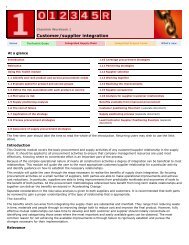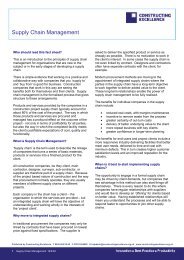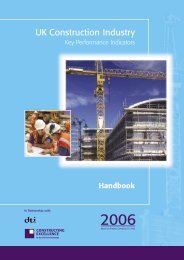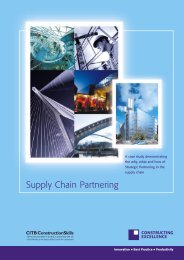Total Safety Management Taylor Woodrow - Constructing Excellence
Total Safety Management Taylor Woodrow - Constructing Excellence
Total Safety Management Taylor Woodrow - Constructing Excellence
You also want an ePaper? Increase the reach of your titles
YUMPU automatically turns print PDFs into web optimized ePapers that Google loves.
■ The participants<br />
The company involved:<br />
■ Contacts<br />
The case study company - <strong>Taylor</strong> <strong>Woodrow</strong><br />
<strong>Taylor</strong> <strong>Woodrow</strong> plc<br />
2 Princes Way<br />
Solihull<br />
West Midlands B91 3ES<br />
T 0121 600 8000<br />
www.taylorwoodrow.com<br />
The programme managers - <strong>Constructing</strong> <strong>Excellence</strong><br />
Publications in this series cover:<br />
■ Creating effective relationships with local schools.<br />
■ <strong>Total</strong> <strong>Safety</strong> <strong>Management</strong>.<br />
■ Strategic partnering within the housing sector.<br />
■ Strategic partnering within the local authority sector.<br />
■ Strategic alliances within the M&E sector.<br />
Each publication looks at an industry problem and then<br />
describes how a group of construction employers have<br />
addressed that problem.<br />
For further information on the skills required for <strong>Constructing</strong><br />
<strong>Excellence</strong> go to www.constructingexcellence.org.uk for an<br />
On-line Skills Assessment.<br />
<strong>Constructing</strong> <strong>Excellence</strong><br />
25 Buckingham Palace Road<br />
London SW1 WOPP<br />
T 0207 837 5702<br />
F 0207 813 3060<br />
www.constructingexcellence.org.uk<br />
The sector skills council<br />
CITB-ConstructionSkills<br />
Bircham Newton<br />
Kings Lynn<br />
Norfolk PE31 6RH<br />
T 01485 577577<br />
www.citbconstructionskills.co.uk<br />
This simple spreadsheet enables people to find out how<br />
they measure up against the skills set required for the whole<br />
<strong>Constructing</strong> <strong>Excellence</strong> Programme.<br />
Researched by MRM Solutions<br />
MRM Solutions Ltd<br />
P O Box 104<br />
Chipping Norton<br />
Oxon OX7 6GD<br />
T 01608 659878<br />
www.mrmsnet.com<br />
<strong>Taylor</strong> <strong>Woodrow</strong><br />
<strong>Total</strong> <strong>Safety</strong> <strong>Management</strong><br />
CITB-ConstructionSkills is working in partnership with CIC<br />
and CITB (NI) as the Sector Skills Council for construction<br />
Innovation ■ Best Practice ■ Productivity<br />
Innovation ■ Best Practice ■ Productivity
<strong>Constructing</strong> <strong>Excellence</strong> aims to achieve a step change in<br />
construction productivity by tackling the market failures in<br />
the sector and selling the business case for continuous<br />
improvement. Through focused programmes in Innovation,<br />
Best Practice Knowledge, Productivity and Engagement,<br />
<strong>Constructing</strong> <strong>Excellence</strong> has developed a strategy to deliver<br />
the process, product and cultural changes that are needed<br />
to drive major productivity improvements in the sector.<br />
Photography courtesy of the CITB-Construction<br />
Skills/Contract Journal “Images of Construction”<br />
Photography Competition 2003<br />
Our strategic objectives are:<br />
■ Improving performance through increased productivity and competitiveness.<br />
■ Improving industry image by taking action to create a step change in culture,<br />
in the development of people, enhanced engagement with the community<br />
and customers.<br />
■ Engagement and Taking Action with individuals, businesses, organisations<br />
and industry associations.<br />
We are organised into four complementary and integrated programmes covering:<br />
■ Innovation - Identifying and promoting tomorrow’s best practice<br />
■ Productivity - Improving the competitiveness of the UK construction industry<br />
■ Best Practice Knowledge - Creating continuous improvement through the<br />
exchange of best practice<br />
■ Engagement - Working with people, businesses and organisations to change<br />
the culture of the industry<br />
Additionally <strong>Constructing</strong> <strong>Excellence</strong> will continue to support a number of specific<br />
initiatives to engage with key sector groups. These include the Housing Forum,<br />
The Local Government Task Force, the Infrastructure Task Force, Central<br />
Government Clients and the Movement for Innovation.<br />
CITB-ConstructionSkills<br />
CITB-Construction-Skills is the Sector Skills Council for Construction and aims to<br />
deliver sufficient skilled people for a world-class construction industry. It helps<br />
the industry to<br />
■ Identify training requirements.<br />
■ Promote progress towards a qualified workforce.<br />
■ Encourage suitable people to enter - and remain in - the construction industry.<br />
■ Encourage, advise, facilitate and help workforce development.<br />
■ Provide direct training where there is no satisfactory market alternative.<br />
■ Promote training by effective use of the funding it collects from industry<br />
through the statutory levy.<br />
■ Encourage Government, industry and other bodies to invest in the skills of<br />
the construction workforce.<br />
<strong>Total</strong> <strong>Safety</strong> <strong>Management</strong><br />
Poor health and safety performance in the house building and<br />
construction industry is a major barrier to profitability and growth.<br />
As the UK becomes more litigious and labour becomes scarce the<br />
direct costs of litigation, insurance and lost productivity coupled<br />
with the indirect costs resulting from loss of investor, customer and<br />
employee confidence may become prohibitive for construction<br />
businesses with poor safety records.<br />
Many see Health and <strong>Safety</strong> of the workforce and protection of<br />
the environment as a prohibitive cost that should be minimised.<br />
Yet this is not the case; the cost is neither prohibitive nor avoidable.<br />
Indeed there is now strong evidence that safe sites are more<br />
productive and profitable than unsafe ones.<br />
This publication describes how <strong>Taylor</strong> <strong>Woodrow</strong> is achieving total<br />
safety management; in the last eleven years it has reduced the<br />
reportable incidents by 50% and outperforms the industry benchmarks<br />
for safety. It has a safety system that encourages all staff to<br />
modify their behaviour so as to prevent accidents. The construction<br />
teams develop safe working practices that often exceed legislative<br />
requirements. These safe working practices are then set as company<br />
standards and transferred across the company through the intranet,<br />
improvement groups and a team of safety advisors. Predictive<br />
measures flag when individual sites are falling behind the high<br />
standards set by the teams and are used to incentivise good<br />
performance and create peer pressure for improvement.<br />
By sharing its experience, <strong>Taylor</strong> <strong>Woodrow</strong> is demonstrating to<br />
other companies what is possible. When others make the same<br />
commitment then the house building and construction industry<br />
will approach that of other sectors both in safety performance<br />
and productivity.<br />
<strong>Total</strong> <strong>Safety</strong> <strong>Management</strong> is part of a suite of in-depth case studies that<br />
describe some of the detail of the <strong>Constructing</strong> <strong>Excellence</strong> Agenda. Each of<br />
the case studies sets out a challenge facing the construction industry and<br />
describes how a company is addressing that challenge.<br />
<strong>Taylor</strong> <strong>Woodrow</strong> is an international housing and development company<br />
employing over 7,000 people worldwide. Its primary business is house<br />
building, with more than 95% of its operating profit coming from developing<br />
new homes in the UK, and other selected markets. In addition to houses,<br />
the company builds a number of commercial property developments,<br />
often combining both housing and commercial properties in mixed use<br />
developments. <strong>Taylor</strong> <strong>Woodrow</strong> also undertakes PFI projects mainly in<br />
healthcare, facilities management and specialist engineering consultancy<br />
through <strong>Taylor</strong> <strong>Woodrow</strong> Construction, where its specialist skills are also<br />
deployed in support of the house building business.<br />
Key messages:<br />
■ 1 Safe business is good business; analysis of productivity<br />
and safety benchmarks within <strong>Taylor</strong> <strong>Woodrow</strong> suggests that<br />
most productive, more predictable and more profitable sites<br />
often have the best safety performance. In an analysis of<br />
50 projects, of the 27 that exceeded the safety benchmark<br />
all but three exceeded their commercial targets; of the 23<br />
that missed the safety benchmark 10 also missed their<br />
commercial targets.<br />
■ 2 Health and safety is a core business goal and central<br />
to a successful strategy; unless this is so Health and<br />
<strong>Safety</strong> will not achieve the level of commitment, resource<br />
and attention required to achieve the target culture.<br />
■ 3 The demands for better health and safety performance<br />
are unstoppable; tighter legislation, the shortages of a<br />
skilled workforce, client and shareholder demands will drive<br />
the industry to better performance.<br />
■ 4 Those companies failing in health and safety will have<br />
higher costs than those succeeding; not only will failure<br />
attract increasingly high fines and threat of litigation, but poor<br />
performance will prevent a company from achieving quality<br />
and delivery standards, being able to hire sufficient labour,<br />
attract sufficient investment to trade and win business from<br />
larger clients.<br />
■ 5 The measures relating to safety must change from<br />
lagging to leading indicators; safety is an area burdened<br />
with statistics most of which are about injury and accident<br />
rates. These lagging indicators do not tell management<br />
that action is needed to prevent accidents; they only tell<br />
management that it has failed. <strong>Taylor</strong> <strong>Woodrow</strong> measures<br />
and reports the level of compliance and the incidences of<br />
good practice. This gives managers advance warning,<br />
allowing them to act before someone gets hurt.<br />
<strong>Taylor</strong> <strong>Woodrow</strong> is committed to being a responsible employer and health<br />
and safety is just a part of its Corporate Social Responsibility agenda.<br />
Corporate Social Responsibility (CSR) applies across all parts of <strong>Taylor</strong><br />
<strong>Woodrow</strong>. CSR is not a separate and distinct activity, it is integral to the way<br />
the company manages its business.<br />
The UK house building and construction industry need not be a<br />
dangerous place to work. There are cost effective ways of introducing<br />
safety to all aspects of the construction process and the experience of<br />
those who have done so is that the business is better managed and<br />
more profitable as a result.<br />
2 <strong>Constructing</strong> <strong>Excellence</strong> ■ <strong>Total</strong> <strong>Safety</strong> <strong>Management</strong><br />
Innovation ■ Best Practice ■ Productivity 3
Why change - the imperative for improving health and safety<br />
Apart from the obvious, that no employer wants to injure or kill<br />
people, there are sound business reasons for addressing the health<br />
and safety performance of the house building and construction<br />
industry. They are:<br />
■ 1. Poor safety performance is expensive<br />
■ 2. Poor safety performance is an indication of poor management<br />
■ 3. Poor safety performance restricts growth<br />
Three reasons to improve safety performance<br />
Reason 1: Poor safety performance is expensive<br />
Poor safety costs employers through increased claims and<br />
increased insurance premiums. Increasingly both employees and the<br />
public are more likely to turn to litigation as a response to an accident or<br />
injury. Bad employers will find themselves paying directly for uninsurable<br />
losses and indirectly through higher insurance premiums.<br />
The UK government estimates that work-based accidents cost<br />
between 2.1 and 2.6% of GDP each year. This means that by<br />
addressing health and safety the average company could grow<br />
by 2.6%. Given that construction has a higher accident rate than<br />
many other industries this figure will be higher for building firms.<br />
An OFT investigation into the provision of employers’ insurance reported<br />
that in 2002 average premiums for employers’ liability insurance rose by<br />
50 per cent, public and product liability by 30 to 40 per cent and professional<br />
indemnity by 30 to 60 per cent” 1 . There is evidence in the trade press of<br />
individual construction companies facing year-on-year rises of 400% and<br />
above. 2 The DTI, through its ‘Construction Insurance Czar’, Paul Hayward,<br />
has been investigating methods of bringing together insurers and the<br />
industry by understanding construction risks and encouraging insurers to<br />
offer improved terms to employers who take safety seriously. 3<br />
Incidents and accidents interrupt the flow of work and are a cause<br />
of absences. The house building and construction industry experienced<br />
8.7 lost days per employee in 2000 through poor health, thus underperforming<br />
manufacturing (6.9) and retailing (5.8). 4 On average 17 days are<br />
lost for each workplace injury. Minimising accidents in the workplace and<br />
improving occupational health increases the effectiveness of the workforce,<br />
while keeping key workers on site.<br />
The Health and <strong>Safety</strong> Executive has and is calling on powers to<br />
fine construction companies. The penalties open to the HSE for bad<br />
safety performance are significant and, if prosecuted, could put many<br />
medium sized firms out of business and threaten the shareholder value<br />
of larger firms.<br />
Reason 2: Poor safety performance is an indicator of poor management<br />
Good management requires the controlled use of labour to deliver a task.<br />
If the supply of labour is unreliable because workers are being injured then<br />
the work cannot be properly managed. If a manager cannot plan effectively<br />
for safe working then it is unlikely that the same manager can plan effectively<br />
to deliver each programme.<br />
Many of the risks on a construction site can be affected by site management<br />
and have a direct impact on the productivity of the site.<br />
Risk<br />
Fall from height<br />
Trips & slips<br />
Material falling<br />
on workers<br />
Impact with<br />
machinery<br />
Potential<br />
causes<br />
Poor scaffolding.<br />
Unrestrained<br />
exposure to<br />
heights.<br />
Unsupported<br />
ladders.<br />
Untidy sites.<br />
Inappropriate<br />
location of<br />
materials.<br />
Poorly defined<br />
walkways.<br />
Poor stacking<br />
Materials in the<br />
wrong place.<br />
Poor traffic<br />
management.<br />
Potential impact<br />
on productivity<br />
Generally poor or dangerous<br />
access will reduce the flow of<br />
materials to the area of work.<br />
Not defining areas for tools and<br />
materials and safe walkways<br />
hinders the movement of people<br />
and materials around the site.<br />
Poor use of storage results in<br />
damage, inventory losses and<br />
wasted time locating materials.<br />
Plant is obstructed and material<br />
access restricted. People take<br />
longer to move around site as<br />
they are continually avoiding<br />
machinery.<br />
The most productive working environments are often factories where the<br />
uninterrupted flow of work, people and materials is a significant factor. By<br />
cluttering up the construction site and ignoring the flow of work the site is<br />
both more dangerous and less productive.<br />
Reason 3: Poor safety performance restricts growth<br />
Restrictions on labour<br />
The skills shortages in the house building and construction industry mean that<br />
increasingly, skilled people will have the capacity to be more discriminating<br />
about the sites on which they work, and they may well choose not to work<br />
on sites or with employers with a bad health and safety record. If a company<br />
has poor credentials it is likely to face difficulty attracting the most skilled<br />
people, with an impact on the quality and speed of work.<br />
Restrictions on investment<br />
For large companies, Corporate Social Responsibility is becoming high on the<br />
agenda of institutional investors. For smaller companies banks and finance<br />
houses are likely to look at the safety record as one of the criteria for lending,<br />
particularly when this record threatens profit of either the company or the job.<br />
Restrictions on risk<br />
The nature of work available to companies with a poor safety record will<br />
reduce. Companies with a poor safety record are unlikely to be able to<br />
secure insurance for high risk work. Given that falls from height are<br />
deemed as high risk and that much domestic refurbishment involves working<br />
above 2m then this trend could impact on the smallest construction firms.<br />
How significant is this problem<br />
The house building and construction industry has a worse record<br />
than many other industries in health and safety which is costing<br />
large amounts of money and is not covered by insurance.<br />
The figures on the house building and construction industry’s health and<br />
safety record are well publicised and the lowlights are listed below.<br />
■ There were 79 house building and construction industry fatalities in<br />
2001/2 and 2,580 reportable injuries. 5<br />
■ The fatality rate was 6.0 deaths per 100,000 employees, in 2001. This<br />
compared favourably to agriculture in that year (8.0), but unfavourably<br />
to extraction/utilities (4.7), manufacturing (1.2), and services (0.4). 6<br />
■ The rate of fatal and major injuries stood at 383 per 100,000 in 2001.<br />
This is worse than agriculture (239.3), manufacturing (195.0),<br />
extractive/utilities (248.5) and services (75.0)<br />
■ The rate of “over three day” injuries was 841 per 100,000 employees<br />
in 2001, this is considerably worse than agriculture (621.9) and services<br />
(422.3) but better than manufacturing (1003.4) and extractive/utilities<br />
(1,281.3). It may also be understated as the industry is one of the<br />
worst for reporting.<br />
■ Fatalities are more likely for older workers and fall from height is the<br />
commonest reason for fatal and major injuries. Steel erectors, crane<br />
drivers and cladders are most likely to be fatally injured in their work,<br />
proportionate to their number. But site workers and general craftsmen<br />
have the most fatalities in absolute terms.<br />
The economic costs of injury to the industry<br />
The HSE calculates the direct economic cost of poor safety at £82 million<br />
per year; this excludes insurance premiums.<br />
Type of incident Average Cost Number occurring <strong>Total</strong> Cost<br />
Serious or Major<br />
£18,531<br />
4000 £74,124,000<br />
Over 3 Day<br />
£562<br />
9000 £5,058,000<br />
HSE Convictions<br />
£7,594<br />
431 £3,273,014<br />
<strong>Total</strong><br />
£82,455,014<br />
The impact of insurance<br />
Insurance does not mitigate the cost of injury and accident.<br />
Many employers believe that most incident costs are covered by insurance.<br />
The reality is usually the opposite as insurance policies don’t cover everything.<br />
They may only pay for serious injuries or damage, or the policy<br />
excess may be greater than the individual amounts concerned. The most<br />
obvious cost is from a person taking time away from work. But there are<br />
other costs too. Often these are not readily apparent from the balance<br />
sheet. Costs typically not covered by insurance are:<br />
■ Lost time ■ Production delays ■ Loss of contracts<br />
■ Investigation time ■ Sick pay ■ Fines ■ Legal costs<br />
■ Repairs to plant and equipment ■ Loss of business reputation<br />
■ Damage or loss of product and raw materials<br />
■ Extra wages, overtime working and temporary labour<br />
HSE estimates that the ratio of insured to uninsured losses ranges between<br />
1:8 and 1:36 i.e. for every £1 covered by insurance the company may<br />
have lost as much as £36 in uninsured costs and other losses.<br />
The business rationale for the programme within <strong>Taylor</strong> <strong>Woodrow</strong><br />
The case for health and safety is, for <strong>Taylor</strong> <strong>Woodrow</strong>, simple: they want<br />
their sites to be a place where people can work and near to which the<br />
public can live without risk of injury or death. Achieving this ensures that:<br />
■ 1. They can operate without fear of prosecution or work being stopped<br />
unnecessarily by failures in safety.<br />
■ 2. Claims, delays and injury relating to safety and health do not add<br />
costs and delay programmes.<br />
■ 3. TW sites gain the reputation amongst employees and subcontractors<br />
as a safe and productive place to work.<br />
Together this ensures the reputation of the company on which its position<br />
in the market place depends.<br />
<strong>Taylor</strong> <strong>Woodrow</strong> has however gone further and quantified the business<br />
rationale. It measures the adherence to safety standards of each development<br />
and tracks this against the commercial performance of the job.<br />
Analysis of the safety and commercial performance of 49 TW Projects<br />
95<br />
Blue bars are the safety scores for projects that<br />
Score on TW <strong>Safety</strong> Assessment<br />
90<br />
85<br />
80<br />
75<br />
70<br />
underperform by 2% or worse. The purple bars are<br />
safety scores for projects which are within 2% of plan.<br />
The line represents <strong>Taylor</strong> <strong>Woodrow</strong>’s current benchmark<br />
for safety.<br />
1 3 5 7 9 11 13 15 17 19 21 23 25 27 29 31 33 35 37 39 41 43 45 47 49<br />
1 Office of Fair Trading website, www.oft.gov.uk<br />
2 See Insurers now refusing claim-free companies Construction News, 20.02.2003, and<br />
5 Construction industry data in this section apart from comparators is from<br />
Consultants face four-fold hike in insurance costs, New Civil Engineer 20.03.2003.<br />
Statistics of workplace fatalities and injuries Construction, HSE, 2003.<br />
3 Insurance guru aims to heal rift, Construction News, 17.04.2003.<br />
6 Comparator figures in this section come from the HSE publications<br />
4 Pulling together:2001 Absence and Labour Turnover Survey, CBI. Health and <strong>Safety</strong> Statistics 2000/01.<br />
The graph above is taken from the regular management information on projects<br />
produced by <strong>Taylor</strong> <strong>Woodrow</strong>. Whilst there are many factors that affect both the safety<br />
and commercial performance of a project not all of which are related, the graph<br />
above does suggest that better managed projects are safer.<br />
4 <strong>Constructing</strong> <strong>Excellence</strong> ■ <strong>Total</strong> <strong>Safety</strong> <strong>Management</strong><br />
Innovation ■ Best Practice ■ Productivity 5
Achieving total safety management at <strong>Taylor</strong> <strong>Woodrow</strong><br />
The drivers of safety within <strong>Taylor</strong> <strong>Woodrow</strong><br />
The skills required<br />
<strong>Taylor</strong> <strong>Woodrow</strong>’s approach to health and safety management has four<br />
■ Good measures: safety is an area burdened with statistics most of which<br />
strands: motivate, enable, ensure and improve. The company motivates<br />
staff through a measurement and reward scheme; it provides the skills and<br />
information to enable staff to work safely via training and its intranet; it<br />
ensures safe working through inspection and advice; and it improves by<br />
adopting good practice that exceeds legislative requirements.<br />
The company has a team of safety advisors who, working independently of<br />
each business unit, advise on and assess the safety management in the<br />
company. Through planned visits and unannounced inspections they<br />
measure the adoption of good practice across the business and advise on<br />
how the working environment can be made safe.<br />
Improvements are developed on site and within each business. The safety<br />
advisors assess the value of each innovation and the best are transferred<br />
across the company via improvement groups, benchmarking and the company<br />
intranet. As more and more sites adopt each innovation then the recognition<br />
for implementing it is downgraded and it soon becomes standard practice<br />
that is expected of all. This way, standards are continually improving.<br />
Company targets are established and business units compete to beat the<br />
targets. The results are published in a league table and bonuses paid on<br />
performance. By regularly raising the targets, <strong>Taylor</strong> <strong>Woodrow</strong> is continually<br />
challenging projects and people to improve their performance.<br />
The motivate, enable, ensure, improve, approach transfers to any size<br />
of business. In <strong>Taylor</strong> <strong>Woodrow</strong> it is delivered by a computer based information<br />
system, a team of advisors and a company-wide improvement programme.<br />
Within a smaller firm these elements would be delivered through short<br />
courses, safety bulletins and safety manuals, the site manager(s) and an<br />
employee (possibly the owner) acting as company-wide safety advisor.<br />
What sets this approach apart from other health and safety schemes<br />
The <strong>Taylor</strong> <strong>Woodrow</strong> approach captures, promotes and rewards<br />
good safety practice and by doing so changes the behaviour<br />
of employees. It does not, like many others, rely on the<br />
number of accidents as a measure of safety performance.<br />
To motivate their staff, TW reports on and incentivises the effective<br />
delivery and implementation of the safety management system. This<br />
motivation changes the behaviour and attitudes of staff to safety.<br />
To enable their staff, TW ensures that all have the relevant<br />
competence and provides access to guidance, training and<br />
information via the company intranet.<br />
To ensure the strategy is met, TW combines a team of professional<br />
safety advisors with a management information system that<br />
reports performance innovation by Business Unit, Region,<br />
Contract and Site managers. There is a bonus for exceeding<br />
target and peer pressure from missing the target.<br />
To improve their approach, TW sets a benchmark that is above<br />
compliance and then through a series of improvement meetings<br />
that start at site and cascade through to the boardroom they<br />
evaluate good practice emerging from site and adopt it as<br />
standard practice.<br />
<strong>Safety</strong> - a business strategy<br />
<strong>Taylor</strong> <strong>Woodrow</strong> is explicit about its strategy. Corporate Social Responsibility<br />
is taken seriously by its customers and investors and so is a key responsibility<br />
of the board. But it is more than a token exercise. The board recognise<br />
both opportunities and threats in safety, health and the environment (SHE).<br />
are about injury and accident rates. These measures indicate past<br />
performance and do not measure the effectiveness of the system or flag<br />
when action is needed. Later in this case study we describe how <strong>Taylor</strong><br />
<strong>Woodrow</strong> measures and reports the level of compliance with the system<br />
and the incidences of good practice. Using such leading indicators they<br />
have a better chance of spotting a failure before it turns into an accident.<br />
■ Competition and peer pressure: the ability to demonstrate success and<br />
be recognised for it. <strong>Taylor</strong> <strong>Woodrow</strong>, by publishing safety performance<br />
across business units, creates competition amongst them.<br />
■ Reward: an incentive for succeeding. <strong>Taylor</strong> <strong>Woodrow</strong> includes safety<br />
performance in the calculation of bonuses within the business.<br />
■ Good management: safety requires clear goals, communication and a<br />
balanced approach. <strong>Taylor</strong> <strong>Woodrow</strong> ensures they have good planning,<br />
effective information and highly skilled individuals delivering safety.<br />
■ Communication: channels for exchanging good practice and discussing<br />
ideas are essential. <strong>Taylor</strong> <strong>Woodrow</strong> has an in-depth intranet resource,<br />
company-wide peer group meetings on safety and a team of specialists.<br />
Achieving a safety culture<br />
A safety culture goes beyond just having the right manuals and procedures.<br />
It requires:<br />
■ A common goal. <strong>Safety</strong> management is pervasive; the aim of everyone in<br />
the organisation from board room to site stores is to be safely profitable.<br />
■ Team effort directed towards making the safety system work. This effort<br />
extends from design to final account (and beyond for facilities management);<br />
designers have to design safety into the structure, estimators and quantity<br />
surveyors account for the cost of safety, planners sequence in good<br />
safety practices and site managers implement it.<br />
People management Information technology Risk management<br />
Strategic planning<br />
Contribution<br />
to policy<br />
setting and<br />
evaluation<br />
Assess and<br />
deal with risks<br />
Specifying and<br />
using IT to<br />
ensure the<br />
effectiveness<br />
of the<br />
H&S system<br />
Leading and<br />
building the<br />
team<br />
Identify and articulate the health and safety policy for the<br />
company/business unit/project.<br />
Promote the aims, values and culture of the organisation<br />
to your clients, colleagues and contractors.<br />
Coach people in achieving health and safety.<br />
Collate opinions, deal with objections and resolve conflicts<br />
relating to health and safety.<br />
Identify the risks associated with the workforce,<br />
development, design or site.<br />
Prioritise the risks posed to health and safety by the<br />
development, design or site.<br />
Quantify the likely implications of the priority risks.<br />
Develop plans, procedures and working practices that<br />
mitigate the impact of the priority risks.<br />
Access information using internet and intranet searches.<br />
Present information combining text and graphics in a written<br />
document.<br />
Present performance information in a spreadsheet.<br />
Store and retrieve information.<br />
Brief the team effectively on safety procedures, risks<br />
and practice.<br />
Identify and deal with inadequate performance.<br />
Support and coach the team and provide feedback on<br />
safety performance.<br />
Establish arrangements for achieving effective<br />
communications between all parties.<br />
Implement procedures for risk assessment.<br />
is the focus on encouraging, measuring and rewarding behaviour<br />
The opportunity is to be perceived by the public as a responsible business;<br />
■ Pride in the site and project. All involved have to take pride in<br />
that creates a safe working environment rather than catching people<br />
who break the rules. <strong>Taylor</strong> <strong>Woodrow</strong> measures the extent to which<br />
total safety management is achieved. This creates leading indicators<br />
of safety that predict where accidents are most likely to happen<br />
allowing management to take action. Contrast this with most safety<br />
measurement which focuses on accidents and incidents; two lagging<br />
indicators that can only tell management that they have already failed.<br />
this assists the company to sell product, recruit people and influence stakeholders.<br />
The threat of ignoring SHE is around corporate liability, increased<br />
fines, less predictability of income, uncertainty of investment and a poor<br />
reputation amongst stakeholders.<br />
<strong>Taylor</strong> <strong>Woodrow</strong> has proved that good safety is good management and<br />
that good management is profitable. They compete for investment capital,<br />
achieving a good reputation for safety.<br />
■ Attention to detail. Planning for and implementing safety in a way that does<br />
not slow the business requires attention to detail and proper scheduling.<br />
■ A balanced approach. The reduction of risk can be disproportionate<br />
and too much done with little impact. There needs to be a balance of<br />
what is possible and what is effective.<br />
<strong>Safety</strong> procedures<br />
Ability to audit<br />
that systems<br />
are followed<br />
and risks<br />
mitigated<br />
Complete the procedures that meet the requirement of the<br />
relevant regulations.<br />
Complete a safety audit of designs, sites and procedures.<br />
Be aware of legal requirements relating to the operation of<br />
construction sites.<br />
staff, and the influence of politicians with companies from many different<br />
sectors. Amongst their peers, good safety is a requirement and poor safety<br />
taken as an indication of lack of management control. The excuse that<br />
construction is dangerous and therefore unsafe is not acceptable at<br />
<strong>Taylor</strong> <strong>Woodrow</strong>.<br />
■ Open management. There must be opportunities to challenge<br />
management decisions and question omissions in either design or<br />
process. Senior management must listen to site concerns and give<br />
equal priority to safety and profit.<br />
■ A drive to exceed standards beyond compliance. There must be<br />
a recognition that the minimum is insufficient.<br />
Construction safety<br />
Knowledge of<br />
environmental<br />
health<br />
and safety<br />
legislation<br />
Understand the role of each of the enforcement authorities.<br />
Identify methods that increase the likelihood of accidents<br />
or are inherently dangerous.<br />
Identify areas of a site or activities on site where health<br />
and safety may be compromised .<br />
Organise health, safety and welfare facilities that are<br />
consistent with contract, statutory, organisation policy<br />
and brief project staff on their responsibilities.<br />
6 <strong>Constructing</strong> <strong>Excellence</strong> ■ <strong>Total</strong> <strong>Safety</strong> <strong>Management</strong><br />
Innovation ■ Best Practice ■ Productivity 7
What to change to achieve total safety management<br />
The three biggest changes required are:<br />
■ 1. An attitudinal change - construction companies need to view<br />
safety and health as an integral part of their management of<br />
the business and ensure safety in design through to handover<br />
and operation of the property.<br />
■ 2. Process change - construction companies need to adopt better<br />
and more effective processes to improve their health and<br />
safety record.<br />
■ 3. Supply chain - to instill the same approach within the extended<br />
supply chain that operates in the construction sector.<br />
<strong>Taylor</strong> <strong>Woodrow</strong> has taken all of these changes on board and is<br />
now achieving performance above the industry average and above<br />
that of its peer group.<br />
The Health and <strong>Safety</strong> Process<br />
There are four parts to the process.<br />
Motivate Enable<br />
Ensure Improve<br />
Motivating the workforce<br />
<strong>Taylor</strong> <strong>Woodrow</strong>’s approach to motivating staff takes account of<br />
the different attitudes to safety that are present in any group of<br />
construction workers.<br />
For those in the workforce who are convinced of the benefits of total<br />
safety management <strong>Taylor</strong> <strong>Woodrow</strong> creates an environment where their<br />
ideas are welcomed and innovations adopted. The safety system recognises<br />
and rewards sites for implementing new ideas by setting them as exemplars<br />
that others are encouraged to copy.<br />
Unconverted<br />
Semi-converted<br />
Converted<br />
Incentivised<br />
Allowed to Compete<br />
Unleashed<br />
For those in the workforce who are less than convinced there are<br />
league tables that show up poor adherence to the safety management system<br />
and incentive payments that encourage good adherence to the safety<br />
management system. The league tables and bonuses work at site, region and<br />
business level. A poor performing site reflects badly on and affects the bonus<br />
of the site manager and all levels of management up to the Director responsible<br />
for that business unit. This carrot and stick approach applied in this way to<br />
the whole management chain focuses that management chain on safety.<br />
Enabling the workforce<br />
The <strong>Taylor</strong> <strong>Woodrow</strong> team understands how to work safely because<br />
they have the information they need and the skills required to use<br />
that information.<br />
Developing the skills<br />
<strong>Taylor</strong> <strong>Woodrow</strong> has developed a skills profile for each role showing which<br />
general courses the person must, should and could do. The skills profile is<br />
linked on the intranet to a course booking system enabling each person to<br />
review their training needs and book onto the courses they must, should<br />
and do need. There is no management authority required to book courses<br />
in this way, thus the team are empowered to develop their own skills.<br />
Courses cover knowledge, safety processes and skills and examples of<br />
course titles people can book include:<br />
Knowledge<br />
Process (Institute of<br />
<strong>Safety</strong> and Health)<br />
Skills<br />
Basic <strong>Safety</strong>, Health and Environment<br />
<strong>Safety</strong> Health and Environment Update<br />
• Directing <strong>Safety</strong> • Managing <strong>Safety</strong> • Supervising <strong>Safety</strong> •<br />
• Client/Contractor Relationships •<br />
• Managing Environmental Issues •<br />
• <strong>Safety</strong> Awareness • Scaffold Awareness • Fire and Emergency •<br />
• Lifting Operations <strong>Management</strong> • Elevating Work Platforms •<br />
• Slinger Banksman Awareness • First Aid • Nets • Fork Truck •<br />
On a day-to-day level the site managers are equipped with “Tool Box Talks”<br />
that allow them to brief the workforce on specific safety issues. There are<br />
78 of these on the <strong>Taylor</strong> <strong>Woodrow</strong> intranet site that cover topics ranging<br />
from Safe Use of Hand Tools, Safe Use of Ladders, Working from Cradles<br />
and Prevention of Falls.<br />
Informing the workforce<br />
Good health and safety is captured in a series of processes for the setting<br />
up, operating and closing down of a site. These processes cover everything<br />
from the site compound through to traffic management. The site team<br />
can access forms and checklists for every stage of the build process.<br />
Additionally there is guidance on other aspects of health and safety; for<br />
example risk management, method statements and standard forms. These<br />
internal documents are supplemented by standard publications such as<br />
CITB Construction Site <strong>Safety</strong> Notes, GE700 and other technical information.<br />
Normally in companies this information is only available to the Health and<br />
<strong>Safety</strong> Team; at <strong>Taylor</strong> <strong>Woodrow</strong> it is available 24/7 to all employees. In<br />
addition to the standard, there is practical guidance on implementing<br />
health and safety. Usually derived from best practice developed on site,<br />
this practical guidance is in the form of descriptions and photographs.<br />
Setting standards by visualisation in this way brings to life the typically dry<br />
materials offered by many reference sources.<br />
As practice improves and procedures change <strong>Safety</strong> Reminders are issued<br />
via email and logged onto the company intranet.<br />
A knowledge based system<br />
Collectively this knowledge base ensures the workforce is informed of both<br />
minimum standards and<br />
good practice required to<br />
plan and deliver a project<br />
safely. For <strong>Taylor</strong> <strong>Woodrow</strong><br />
this is implemented via the<br />
company’s intranet site<br />
- Tayweb - to which a<br />
majority of employees<br />
have access.<br />
Area<br />
Processes<br />
Knowledge<br />
Measurement<br />
Competence<br />
Improvement<br />
Groups<br />
The Team<br />
Occupational<br />
Health<br />
OHSAS<br />
18001<br />
Purpose<br />
To explain<br />
how the<br />
safety process<br />
operates<br />
A single point<br />
of access to<br />
internal and<br />
external<br />
information<br />
on safety<br />
To set out<br />
what is<br />
measured<br />
and how it<br />
is measured<br />
Details of the<br />
skills required<br />
and training<br />
available<br />
Details of<br />
how the<br />
improvement<br />
processes<br />
operate<br />
An<br />
organisation<br />
chart for the<br />
safety advisors<br />
To ensure the<br />
health and<br />
well being of<br />
all employees<br />
A Health<br />
and <strong>Safety</strong><br />
Standard<br />
Examples of information held<br />
■ Health and <strong>Safety</strong> Plan<br />
■ Where to find advice<br />
■ How to measure<br />
■ Incident response<br />
■ Process forms and documentation<br />
■ External information<br />
• CITB Yellow Bible<br />
• CIP Blue Bible<br />
• British Standards Online<br />
• HSE information<br />
• Barbour index<br />
• SYPOL covering COSHH<br />
• H&S Related Websites<br />
■ Internal information<br />
• Company policy and strategy<br />
• Risk Assessment Standards<br />
• Innovations - how to achieve total safety<br />
• Toolbox Talks<br />
• Site <strong>Safety</strong> Starter Pack<br />
• <strong>Safety</strong> Reminders<br />
• <strong>Safety</strong> Manual<br />
• <strong>Safety</strong> Newsroom<br />
■ <strong>Management</strong> Performance - quarterly league tables<br />
summarising the findings of document audits<br />
■ Site Inspections - quarterly league tables summarising<br />
the findings of observational audits<br />
■ Benchmarks - statistics on health and safety<br />
performance for the industry<br />
■ Training matrix<br />
■ Details of courses and online booking for training needs<br />
■ Details of competency targets & MCG accepted schemes<br />
■ Corporate Social Responsibility Policies<br />
■ CSR Meeting Schedules<br />
This chart shows who to contact and how for<br />
a range of safety advice. It is “hot linked” for<br />
ease of emailing.<br />
■ Company policies<br />
■ Medical Advice and Guidance<br />
■ Health Screening<br />
■ Subcontractor Health Screening<br />
Online access to the standard<br />
Ensuring safety<br />
<strong>Safety</strong> happens because staff are motivated, trained, informed<br />
and responsible.<br />
The safety regime involves the whole workforce; main board directors are<br />
involved in strategy and reporting; regional directors and business units are<br />
held accountable for performance, and operations (design, costing, procurement<br />
and engineering staff) are responsible for creating safe approaches<br />
to construction.<br />
A significant part of the management system is the audit regime that involves<br />
the advisor working with each site. This takes two forms: the scheduled<br />
<strong>Management</strong> Performance Audit checks that the procedures are in<br />
place and the unscheduled Site Inspection checks the implementation<br />
of those standards.<br />
The <strong>Management</strong> Performance Audit - To establish the management<br />
of the site complies with the Health and <strong>Safety</strong> Plan the advisor visits 3, 6<br />
and 12 monthly according to risk (higher risk sites receive more frequent<br />
visits). They are evaluated on a predetermined schedule and scores reported<br />
to all in the management chain up to and including the Managing Director<br />
of the Business unit.<br />
The Site Inspection - measures the operational effectiveness of the<br />
works on site. The site is visited unannounced and checked against a<br />
series of standards. The rating system is a ten-point scale where 10, 9<br />
and 8 reflect activities that go beyond that required by law.<br />
Score Meaning<br />
Status<br />
10<br />
9<br />
8<br />
7<br />
6<br />
5<br />
4<br />
3<br />
2<br />
1<br />
0<br />
Unique - this is the first time the Advisor has<br />
seen this<br />
A model of good practice adopted by less than 25%<br />
of TW sites<br />
Good practice adopted by less than 50% of TW sites<br />
Meets the law - it is standard industry practice<br />
Dangerous review and correct<br />
Correct within a week<br />
Correct within three days<br />
Correct within one day<br />
Correct immediately<br />
Stop the activity<br />
Stop the job<br />
Above compliance<br />
Compliance<br />
Non conformance<br />
The results of each inspection are published through the management chain<br />
at the time of visit. They are consolidated and reported at site, area and<br />
business level. The safety performance of each Director and those who report<br />
to him/her is published and used to calculate part of the bonus payment<br />
to each business. Publishing these figures is a key motivator for improvement.<br />
The checklist is revised as new innovations are adopted more widely<br />
across the company. When an innovation is first identified it scores 10,<br />
when more than 25% of sites do it, the score is reduced to 9; when more<br />
than 50% do it the score is reduced to 8 and when it becomes the industry<br />
norm it is reduced to a score of 7. This way people are forced to continue<br />
innovating to top the league table and maintain the score required to<br />
achieve the bonus payments.<br />
8 <strong>Constructing</strong> <strong>Excellence</strong> ■ <strong>Total</strong> <strong>Safety</strong> <strong>Management</strong><br />
Innovation ■ Best Practice ■ Productivity 9
The safety advisor<br />
The safety advisors are part of a national team that is regionally based but<br />
not linked to any one business unit. They add expertise and help the business<br />
to ensure it is delivering its responsibility to operate safely. Each business<br />
owns the safety process; the advisor is there to coach and mentor those<br />
responsible for the processes.<br />
■ Engaging subcontractors in safety - <strong>Taylor</strong> <strong>Woodrow</strong>’s specification<br />
The safety advisor<br />
Improving safety<br />
- the <strong>Taylor</strong> <strong>Woodrow</strong> improvement cycle<br />
and procurement of bought-in goods and services play a key role in<br />
ensuring safety. The buyers ensure that the most suitable suppliers are<br />
selected and provide proper risk assessment and method statements<br />
but again it is the site manager who has to ensure these are followed.<br />
There is a growing understanding amongst the <strong>Taylor</strong> <strong>Woodrow</strong>’s sub<br />
Aim<br />
Organisation<br />
To achieve a consistently high standard for safety across<br />
all sites in the region.<br />
Reporting via safety manager to company secretary and<br />
based in a region.<br />
<strong>Safety</strong> performance is improved in a three stage improvement cycle. A new<br />
idea is introduced by a site which then scores highly in an inspection; it<br />
(and the high score) is noticed when it raised at peer to peer safety<br />
reviews, seen on the intranet or discussed by a safety advisor. As more and<br />
The health and safety people<br />
Everyone in the company is engaged in some way with the management<br />
but the two roles that have greatest impact are the site manager and the<br />
contractors that they will not be let on to site without proper equipment,<br />
induction and methods statements. They recognise that if a ground<br />
working gang turns up on site without 360 0 vision on an excavator<br />
then they will lose money whilst they fit one. This creates tensions for<br />
the site manager who is faced with the dual pressures of finishing the<br />
Regular Tasks<br />
Coach and mentor those within the business.<br />
Unannounced site audits.<br />
Planned audits.<br />
Contributing to and documenting safety improvements.<br />
Exchange of best practice.<br />
more sites adopt the innovation the score associated with it is downgraded<br />
forcing those competing for the highest score (or looking to keep their<br />
safety advisor.<br />
job and adhering to the system. The site manager with the support of<br />
senior management enforces a zero tolerance approach and the problem<br />
Relationship<br />
with site<br />
An expert advisor to promote best practice.<br />
bonus) to develop new ideas.<br />
The site manager<br />
The site manager is responsible for controlling the greatest number and<br />
is passed to the source i.e. the subcontractor who failed to achieve the<br />
standard. <strong>Taylor</strong> <strong>Woodrow</strong> site managers and procurement teams know<br />
Greatest challenge<br />
Ensuring that the supply chain takes safety as seriously<br />
as the full-time team and integrates with the TW system.<br />
Innovations and good practice<br />
most serious risks to health and safety. The key challenges for the site<br />
who the reliable subcontractors are and select accordingly. “Once bitten,<br />
The following are examples of innovations which have been developed on<br />
manager are:<br />
twice shy” features strongly in the selection of contractors.<br />
site and spread throughout the company.<br />
The safety advisors benchmark their work to ensure consistency, align their<br />
■ Setting the site up for safety - <strong>Taylor</strong> <strong>Woodrow</strong>’s guides to site set<br />
■ Delivering safety in a changing environment - <strong>Taylor</strong> <strong>Woodrow</strong> site managers<br />
thinking on safety and to exchange ideas to achieve this they will all visit<br />
Skin Care Centres<br />
All <strong>Taylor</strong> <strong>Woodrow</strong> sites are now equipped with skin care<br />
centres that include barrier bream, hand cleanser and<br />
restorer (in addition to soft soap).<br />
up and the exchange of good practice amongst other sites are important<br />
but allowing the site manager sufficient time and the right support from<br />
the business are critical to getting safety right from the outset. It is at set<br />
are faced with creating an efficient and safe working environment on<br />
sites that are continually changing. “It is not like a production line in a<br />
factory, the risks move as the site changes”. The ultimate goal is zero<br />
one site simultaneously and make the same assessment of its safety practices.<br />
They then compare and debate results until there is consistency. After<br />
doing this repeatedly over 30 months they have reduced the standard<br />
Housekeeping<br />
Where trades establish a working area they are required to<br />
include a bin for off-cuts of materials rather than allowing<br />
the waste to be scattered around the work area.<br />
up that the greatest difference is made to both safety performance and<br />
site productivity. By establishing a layout that allows safe and efficient<br />
flows of materials and labour, many problems and delays are avoided.<br />
tolerance of safety breaches; no personal protective equipment - no<br />
admittance; no parking outside of the parking area; no untied ladders;<br />
no breaches of site boundaries. This is reflected in the scoring that identifies<br />
deviation in the average of scores awarded by each inspector from 4.88<br />
to 0.77. This approach ensures consistency across all businesses, enables<br />
transfer of good practice and prevents the safety team going native or<br />
Helmet<br />
Mounted Visors<br />
All TW branded helmets are provided with pulldown visors.<br />
This ensures that eye protection for general operations is<br />
always available.<br />
<strong>Taylor</strong> <strong>Woodrow</strong> pays particular attention to the location of on-site<br />
stores, traffic management and safe walkways. On sites where some of<br />
the houses will be sold before the site is fully developed good segregation<br />
these breaches of requirements and impacts on the reward achieved by<br />
the management.<br />
being influenced by the pressures of the business.<br />
In addition to regional and divisional responsibilities members of the team<br />
All round vision<br />
on mobile plant<br />
Fire points<br />
Mirrors and/or close circuit television are now required on<br />
any mobile plant on site that has restricted all round vision,<br />
irrespective of the use of banksmen.<br />
A standard fire point containing suitable fire fighting and<br />
warning systems has been identified and is now used<br />
throughout <strong>Taylor</strong> <strong>Woodrow</strong> sites.<br />
of public and site through proper fencing and traffic management are<br />
a priority.<br />
The site manager<br />
Aim<br />
To achieve safe production on schedule.<br />
Organisation<br />
Reporting to a production director or manager within a<br />
business stream.<br />
■ A lot of time is spent ensuring that new contractors have a site induction,<br />
understand the regime that safety is adhered to and rules are kept. The<br />
second rule is enforcing the system so the site is safe and productive: if<br />
the parking area is a mile away from the work then a good site manager<br />
will arrange a shuttle from the car park to site; if lifting gear is needed<br />
then it is made available; labourers are on hand to move walkways to<br />
allow access; if fall protection is required then it is ordered ahead of the<br />
roofing gang arriving.<br />
also have a watching brief over a particular area of processes and legislation.<br />
They have three levels of competence linked to the Institute of <strong>Safety</strong> and<br />
Health (IOSH); 1 Registered <strong>Safety</strong> Practitioner, 2 Member of the Institute<br />
of Health and <strong>Safety</strong>; 3 Technician <strong>Safety</strong> Practitioner. Each has a twiceyearly<br />
performance review and a twice-yearly development appraisal.<br />
The combined effect of the four stage policy of Motivate, Enable,<br />
Ensure and Improve is to secure a safety culture in which behaviours<br />
A perfect 10 - skin care centres<br />
All <strong>Taylor</strong> <strong>Woodrow</strong> Sites are now equipped with skin care centres that<br />
include barrier bream, hand cleanser and restorer (in addition to soft<br />
soap). This innovation spread across the company without any directive<br />
Key Tasks<br />
Ensuring site safety.<br />
Achieving the revenue plan for the site.<br />
Ensuring the correct flow of materials and labour to<br />
keep the project to plan.<br />
The site managers’ goal is achieving total safety by enforcing all the rules,<br />
without getting in the way of peoples’ work. When they have the motivation,<br />
resources, training and skills they will take ownership of both enforcing and<br />
are modified and the environment made safe.<br />
from management.<br />
Relationship with<br />
safety advisor<br />
Greatest challenge<br />
A source of advice but also an enforcer of safety.<br />
Ensuring that everyone buys into safety.<br />
developing the safety approach.<br />
One site manager estimated 1 day a week is dedicated entirely to safety and<br />
50% of any time on site is looking for risks and ensuring that rules are adhered to.<br />
10 <strong>Constructing</strong> <strong>Excellence</strong> ■ <strong>Total</strong> <strong>Safety</strong> <strong>Management</strong><br />
Innovation ■ Best Practice ■ Productivity 11


